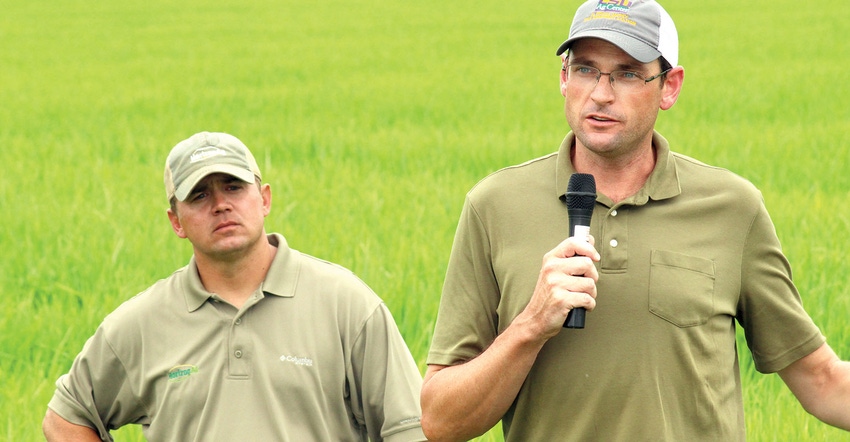
Weedy rice continues to cause Louisiana growers increasing grief, but despite its proliferation, many rice fields look surprisingly good. “We know it’s a big problem and will probably get worse, but I’ve seen a lot of rice across our state, and I was pleasantly surprised at its progress,” said Michael Fruge, district field representative, Horizon Ag.
Fruge was addressing farmers attending Horizon Ag’s 2019 field day held again this year at Richard Farms in Kaplan, La. Growers who had 1 or 2 acres of the problem weed in 2018 have seen it spread to 30 or 40 acres this year.
A growing number of rice farmers are rotating the Provisia technology system into their operations. “Last year was our first year, on a broad scale, with PVL01, and I think everyone learned a great deal about managing the technology with the variety,” says Fruge. “Growers understand the need to properly manage the technology to preserve it.”
There was damage from applications of Provisia in 2018, whether or not the rate was 13 ounces or 15 ounces. “I’ve had only one call so far this year, and it was one of the earliest fields sprayed in our state,” says Fruge. “Research from the LSU AgCenter tells us that it would be advantageous to reduce the levels of nitrogen being applied to PVL01.”
Fruge believes that in fields where high populations of weedy rice exist and where farmers may be losing yield, Provisia can be used to sustain yields and start cleaning up the weedy rice problem. “Over my time in the rice industry, it’s probably the best herbicide I’ve seen for all of the grasses you might have in your field,” says Fruge. “We had some escape last year, not as many this year, and I think that comes from better management practices.”
Spray Volume
Provisia is a contact herbicide and Fruge stressed the importance of water volume during its application. “I really like to see it applied at a rate of 13 gallons an acre,” says Fruge. “If you’re willing to put 15 gallons with it, that’s fine, too.”
PVL01 is susceptible to sheath blight and blast. Two fungicide applications have shown to offer better control, but the volume of water in the mix is key. “Over the years, we’ve been decreasing our fungicide spray volume. Now we have some growers taking it down to 3 gallons an acre,” says Fruge. “Less water will not get the product down into the canopy and that makes it less effective.”
There are two short videos from Mississippi State University taken from a static, field-mounted camera. The purpose of the videos is to show how two different spray volumes change application coverage. “When a 10-gallon rate was used, you could clearly see the water droplets falling on the field,” says Fruge. “When the rate was dropped to 5 gallons, all you could see was a mist.”
The two videos may be viewed via the following links: 5-gallon rate: http://bit.ly/2G5ySvt; 10-gallon rate: http://bit.ly/32mV2Tp.
Rice Breeding Pipeline
Dr. Adam Famoso, assistant professor, LSU Rice Research Station, Rayne, La., shared time on the program with Fruge, and told growers progress has been made with PVL02, but it will not be the final variety in the Provisia line. “All of our material is now second generation, and we’ve crossed those lines back into our more adaptive and typical germplasm,” says Famoso. “Most likely the next variety we release will be another second-generation line, but it will be much more agronomically advantageous — like we’re used to seeing from our Clearfield and conventional varieties.”
Famoso plans on chipping away every two to three years at different traits that will improve Provisia varieties and increase their overall performance.
He is developing two experimental long-grain Clearfield varieties. One is CL2097 and the other is CL2195. They both exhibit increased yield potential. “We’re in the final year of testing these so we can get them to our growers,” says Famoso. “We’re also simultaneously doing foundation seed increases.”
A final decision on both of these lines will be made when all of the year-end yield and quality data has been accumulated.
About the Author(s)
You May Also Like




